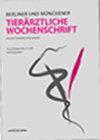Haemorrhagic septicaemia (septicaemic pasteurellosis) in cattle in Baden-Wuerttemberg (Germany)
IF 0.6
4区 农林科学
Q4 VETERINARY SCIENCES
Berliner und Munchener tierarztliche Wochenschrift
Pub Date : 2020-08-31
DOI:10.2376/1439-0299-2020-8
引用次数: 3
Abstract
Haemorrhagic septicaemia (septicaemic pasteurellosis) caused by Pasteurella (P.) multocida capsular type B has been diagnosed in cattle in the federal state of Baden-Wuerttemberg (Germany) for the first time in June 2019 since its last official report in Germany in 1986 and its reoccurrence in 2010. A total of 13 cattle succumbed to sudden death on four farms located in the northern part of the Black Forest between June and November 2019. Post-mortem examinations were carried out on seven of these animals and all displayed marked hyperaemia, haemorrhages and oedema in the subcutis and in several inner organs. The pathological-anatomical findings were confirmed by histopathological analyses. Cultivation of P. multocida was successful in five of seven cattle with high bacterial loads in internal organs, and poor growth in two animals. All isolates were clearly identified as P. multocida by MALDI-TOF mass spectrometry and were compared with isolates originating from an HS outbreak in eastern Germany in summer 2010 using Fourier transform infrared (FT-IR) spectroscopy. Molecular capsular and LPS genotyping assigned six of the isolates to the genotypes B:L2 and one to B:L6, respectively. All isolates belonged to the RIRDC MLST genotype ST122. Antimicrobial testing of P. multocida isolates originating from each farm based on the determination of minimal inhibitory concentration (MIC) revealed susceptibility to ampicillin, ceftiofur, enrofloxacin, florfenicol, penicillin G, tetracycline, and tulathromycin. Resistance was determined for spectinomycin.德国巴登-符腾堡州牛的出血性败血症(败血性巴氏杆菌病)
2019年6月,巴登-符腾堡州(德国)的牛中首次诊断出由多杀性巴氏杆菌(P.)荚膜B型引起的出血性败血症(败血性巴氏菌病),这是自1986年德国最后一次正式报告该疾病并于2010年再次出现以来的首次。2019年6月至11月期间,位于黑森林北部的四个农场共有13头牛猝死。对其中7只动物进行了尸检,所有动物的皮下和几个内脏都出现了明显的充血、出血和水肿。病理解剖结果经组织病理学分析证实。多杀假单胞菌在7头牛中有5头培养成功,内脏细菌含量高,2头生长不良。所有分离株均经MALDI-TOF质谱鉴定为多杀假单胞菌,并利用傅里叶变换红外(FT-IR)光谱与2010年夏季德国东部HS暴发的分离株进行比较。分子荚膜和LPS基因分型分别鉴定了6株和1株基因型分别为B:L2和B:L6。所有分离株均为rdc MLST ST122基因型。基于最小抑制浓度(MIC)的测定,对来自每个农场的多杀假单胞菌进行抗菌测试,结果显示对氨苄西林、头孢替弗、恩诺沙星、氟苯尼考、青霉素G、四环素和图拉霉素敏感。对大观霉素进行耐药性测定。
本文章由计算机程序翻译,如有差异,请以英文原文为准。
求助全文
约1分钟内获得全文
求助全文
来源期刊
CiteScore
0.90
自引率
0.00%
发文量
0
审稿时长
18-36 weeks
期刊介绍:
The Berliner und Münchener Tierärztliche Wochenschrift is an open access, peer-reviewed journal that publishes contributions on all aspects of veterinary public health and its related subjects, such as epidemiology, bacteriology, virology, pathology, immunology, parasitology, and mycology. The journal publishes original research papers, review articles, case studies and short communications on farm animals, companion animals, equines, wild animals and laboratory animals. In addition, the editors regularly commission special issues on topics of major importance. The journal’s articles are published either in German or English and always include an abstract in the other language.

 求助内容:
求助内容: 应助结果提醒方式:
应助结果提醒方式:


